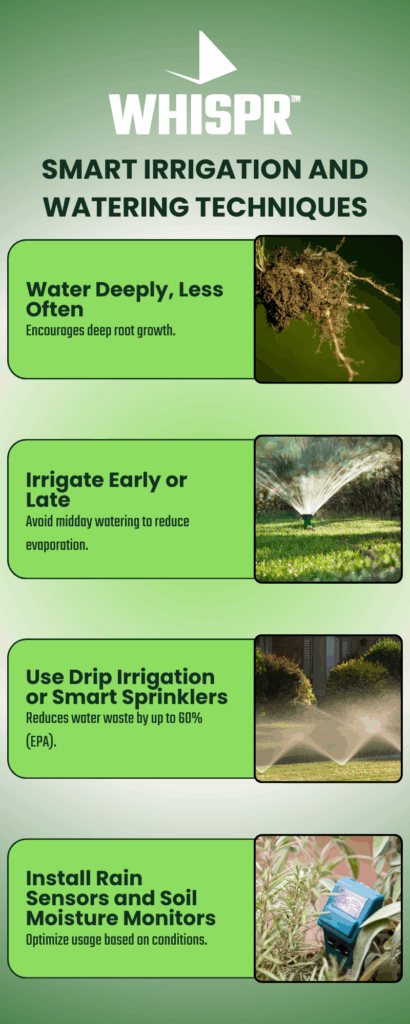In an era of increasing climate unpredictability, homeowners and property managers face a crucial challenge: maintaining beautiful, vibrant landscapes while conserving water. Drought conditions are more common than ever, and traditional lawn care methods are no longer sustainable.
At Whispr, we’re pioneering a greener future with innovative, eco-friendly lawn care services powered by zero-emission robotic mowing and electric landscaping. Our mission? To help you elevate your outdoor space while promoting environmental harmony. Here’s how you can be part of the change.
1. Understand the New Landscape: Why Drought-Resistant Lawn Care Matters
Droughts are becoming a persistent reality in many regions. According to the National Integrated Drought Information System (NIDIS), nearly half of the U.S. experiences drought conditions each year. Water restrictions and rising utility costs make traditional lawn care unsustainable.
What this means for you:
Adopting drought-resistant practices isn’t just about survival; it’s about thriving in an eco-conscious way. It’s time to rethink how we care for our lawns—from plant selection to maintenance methods.
2. Choose the Right Grass and Plants
The foundation of a drought-tolerant lawn begins with what you plant.
Smart Plant Choices:
- Native Grasses: Adapted to local climates and require less water. In the Pacific Northwest, fine fescue or bentgrass are excellent.
- Ground Covers: Clover, thyme, or creeping sedum provide greenery with minimal water.
- Ornamental Grasses and Xeriscaping Plants: Lavender, sage, and blue oat grass are not only beautiful but water-wise.
Pro Tip:
Work with local nurseries or a Whispr lawn care consultant to choose region-specific plants.

3. Embrace Smart Irrigation and Watering Techniques
Watering wisely is critical to sustainability and plant health.
Best Practices:
- Water Deeply, Less Often: Encourages deep root growth.
- Irrigate Early or Late: Avoid midday watering to reduce evaporation.
- Use Drip Irrigation or Smart Sprinklers: Reduces water waste by up to 60% (EPA).
- Install Rain Sensors and Soil Moisture Monitors: Optimize usage based on conditions.
Whispr Advantage:
Our robotic lawn services keep grass height optimal for moisture retention, and our experts consult on smart irrigation setup.
4. Improve Soil Health and Mulch Like a Pro
Healthy soil is key to a water-efficient yard.
Tips for Soil Success:
- Compost Regularly: Enhances water retention and nutrients.
- Use Organic Mulch: Reduces evaporation and suppresses weeds.
- Aerate Soil: Improves absorption and root access.
Bonus Insight:
Whispr’s services include eco-conscious composting and soil enhancement to improve drought resistance.
5. Optimize Lawn Maintenance with Eco-Friendly Practices
How you mow makes a big difference in water conservation.
Smart Maintenance Moves:
- Mow High (3–4″): Shades soil and reduces evaporation.
- Leave Clippings: Acts as natural mulch.
- Use Electric Equipment: Avoids emissions and excessive heat.
Whispr Insight:
Our robotic electric mowers work autonomously, ensuring consistent height and eco-efficiency—quietly and cleanly.
6. Robotic Mowing vs. Traditional Mowing: A Comparative Breakdown
Feature | Robotic Mowing (Whispr) | Traditional Mowing |
|---|---|---|
Emissions | Zero-emission electric | Gas-powered, high emissions |
Noise Levels | Ultra-quiet | Noisy and disruptive |
Water Conservation | Maintains grass height | Often cuts too short |
Labor & Time | Fully autonomous | Manual operation needed |
Soil Compaction | Lightweight, low impact | Heavy equipment compacts soil |
Safety | Sensor-controlled | Operator-dependent |
Eco-Friendliness | Battery-powered | Fossil-fuel dependent |
Cut Quality | Precise, daily trimming | Weekly cuts, variable quality |
Conclusion:
Robotic mowing outperforms in every way that matters to a sustainable lawn.
7. Drought-Tolerant Plants by Climate Zone
Every region has unique needs. Here’s a breakdown:
Southwest (Hot & Arid):
- Best Plants: Buffalo Grass, Blue Grama, Yucca, Desert Marigold
- Style: Xeriscaping with gravel and succulents
Pacific Northwest (Mild & Moist Winters):
- Best Plants: Fine Fescue, Sword Fern, Oregon Grape
- Tip: Pick plants that balance wet winters and dry summers
Midwest (Seasonal Extremes):
- Best Plants: Tall Fescue, Black-eyed Susan, Prairie Dropseed
- Tip: Mix prairie flowers with deep-root grasses
Southeast (Hot & Humid):
- Best Plants: Zoysia, Centipede Grass, Lantana
- Tip: Use mulch and shade-tolerant ground covers
Mountain West (Cooler, High Elevation):
- Best Plants: Sheep Fescue, Penstemon, Columbine
Tip: Choose hardy natives that withstand rocky, dry soil
8. Know Your Local Incentives and Regulations
Ways You Can Save:
- Rebate Programs: For smart irrigation and turf replacement
- Landscape Ordinances: May mandate water-efficient designs
- Rainwater/Graywater Systems: Often supported by local codes
Whispr Pro Tip:
We’ll help you identify and apply for rebates in your area.
9. DIY Checklist: How to Make Your Lawn Drought-Resistant
Choose native or drought-tolerant plants
Upgrade to smart or drip irrigation
Add 2–3 inches of organic mulch
Raise mower blade to 3″–4″
Leave grass clippings in place
Aerate and compost your soil annually
Test your soil’s health
Group plants by water needs
Book a check-in with your Whispr lawn consultant
10. Myths vs. Facts: What You Might Be Getting Wrong
Myth: Drought-resistant lawns look dry
Fact: They’re vibrant and lush with proper care
Myth: Native grasses can’t handle foot traffic
Fact: Many are as tough as conventional sod
Myth: All mulch is the same
Fact: Organic mulch retains water and supports soil health
Myth: More watering means greener grass
Fact: Strategic watering builds stronger roots
Myth: Smart irrigation is too expensive
Fact: Rebates and water savings make it cost-effective
Conclusion: Sustainability Starts With You
Water is precious—and your lawn can be both beautiful and responsible. With Whispr, drought-resistant landscaping becomes simple, quiet, and sustainable.
Schedule your consultation with Whispr and take the first step toward a quieter, greener lawn.
FAQs
What is the most drought-tolerant grass type?
Bermuda, buffalo grass, and fine fescue are excellent due to their deep root systems.
Can I install a smart irrigation system myself?
Yes, and Whispr offers guidance or full-service installation support.
Does robotic mowing really help conserve water?
Absolutely. It keeps grass at an ideal height and minimizes soil stress, both crucial for water retention.

